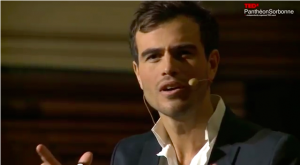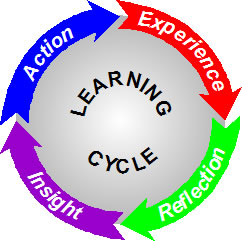“Experiential learning is a teaching and learning process that combines direct experience that is meaningful to the student with guided reflection and analysis. It is challenging, active and student centered and immerses students in opportunities for taking initiative, responsibility and decision making. It is a holistic approach to learning that connects the head with the body, heart, spirit and soul. Traditional academic approaches to education focus primarily on the intellectual development of the individual while experiential education methods focus on the whole person” (Kolb)
The below article about the gain of experiential learning was written by Kim Lamoureux and published in the review Leadership Experience on October, 10. 2009.
« Experiential Learning. Make it the core of the Leadership program. » by Kim Lamoureux
LEADERS PARTICIPATE IN many training activities—workshops, online courses, assessments, coaching—to prepare for real-world challenges. Mastery, however, demands experience; hence, companies have to facilitate and accelerate a person’s ability to gain experience. Organizations that offer experiential learning (EL) enable leaders to master something by applying learning and receiving feedback.
Try three types of Experiential learning events for Leadership:
Simulation.
Simulations help leaders see how various functions are interrelated and contribute to success. With little risk, leaders can experiment with different decision scenarios in various areas of the business.
At Sun Microsystems, the Leadership Connections program includes a custom-designed, fiveday simulation in which four VPs each facilitate and coach a team of six directors. VPs arrive early to rehearse their roles and practice coaching. Teams are challenged to run a simulated version of Sun’s business as CEOs over a three-year period. At the end of each day, teams receive feedback on their results and are ranked among each other. Teams then present key learning and recommended solutions to leaders.
During the simulation, consultants facilitate Leader Lab feedback sessions designed to reinforce Sun leadership competencies and values. These labs enable VPs and directors to share learning goals and desired leadership behaviors—and receive feedback and explore team dynamics in real-time. Each VP also helps directors link their simulation learning to their real worlds.
Job rotation.
Job rotation involves moving a leader through a series of jobs designed to broaden knowledge of operations and prepare for advancement.
The executive council-sponsored director-level rotation program at HP enables participants to take on a new job in a different business, function or geography, which helps to ready high potentials for their next roles. Positions are identified for a two-year rotation. High potentials are nominated and selected to participate. Participants are assigned an executive-level sponsor and an external executive coach, who takes them through a two-hour behavioral interview and the creation of a development and coaching plan. The hiring manager assigns a mentor to help participants get up to speed as quickly as possible and support the leader throughout the rotation. The depth and breadth of exposure to different businesses helps leaders glean fundamental and universal principles that build their philosophies about business leadership.
Action learning.
Action learning is a dynamic approach that utilizes teams of four to six people for solving business problems. Leaders are evaluated on how they perform under pressure to make decisions, define recommendations and deliver solutions; the team is assessed on how well they function collectively and achieve goals.
Through its Center for Collaborative Leadership and executive engagement, Cisco Systems has a progressive Leadership
approach, referred to as the Executive Action Learning Forum (E-ALF). This 16week program includes academic study, role play, and the development of a product or business idea, enabling participants to experience a true leadership experience while executing strategy.
Participants attend a five-day offsite, where six teams of 10 people each are formed. The teams include a subject matter expert, executive coach, and senior executive. Team members meet as a group and as individuals with their coach, who remains with them throughout the process. The teams are assigned to their project and then disperse to their business units, but continue to work virtually on developing their idea. Sub-teams work on certain elements. During the second half, the team refines their proposals, meets with stakeholders, and gathers feedback. At the end, participants give a final presentation.
Experiential learning is a key element in Leadership strategy and program design. Experiential learning enables leaders to apply learning and receive feedback in real-time, and enables companies to observe the capabilities of leaders.
Kim Lamoureux is Principal Analyst, Bersin & Associates. Visit www.Bersin.com.










